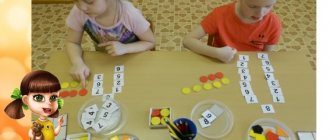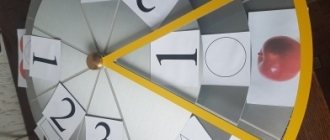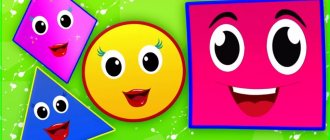Mathematics
PREFACE
Changes in the content of schooling have significantly increased the requirements for the level of mathematical understanding of kindergarten graduates.
The need to establish continuity in the work of kindergarten and school is reflected in the title of the book - “Mathematics in Kindergarten”.
The concepts of natural numbers, geometric figures, quantities, etc., which children have to learn in school, are abstract, but they reflect the connections and relationships inherent in objects in the outside world.
The primary source of knowledge is sensory perception derived from experience and observation. In the process of sensory cognition, ideas are formed - images of objects - their properties and relationships.
Understanding the logical definitions of concepts is directly dependent on how children go through the first sensory stage of cognition.
The richer their ideas about the quantitative and spatial properties and relationships of real objects, the easier it will be for them in the future to move from these ideas to mathematical concepts through generalization and abstraction.
Successful mastery of mathematical concepts is directly dependent on the development of perception, i.e., sensory development of children. The very ability to generalize and abstraction develops on the basis of the practice of identifying the properties of real objects, comparing and grouping them according to the selected properties. Therefore, special work on the formation of mathematical concepts is carried out throughout preschool childhood in close connection with all educational work in kindergarten.
Children receive elementary ideas about set and number, about the relationships of quantities, about the simplest geometric figures, about the main spatial directions and relationships between objects, about the duration of certain time periods (days, weeks, months). They master ways of identifying quantitative and spatial relationships: practical comparison of numbers of sets (overlapping, applying, pairing, using labels, etc.), comparing the sizes of objects, counting and measuring quantities.
h
Learning to measure quantities allows you to deepen the concept of number. When learning to count, preschoolers often develop an incompletely correct approach to estimating quantities. The unit is perceived by them as a separate object, separateness, outside of its quantitative content.
In the process of measurement, the unit of measurement (measurement) seems to split the measured quantity (length, volume) into parts, each of which is equal to it. The number obtained as a result of measurement clearly acts as an indicator of the relationship between the whole and its part. Measurement emphasizes the relativity of a number, its dependence on the size of the chosen measure: the larger the measure, the smaller the number obtained as a result of the measurement. Teaching children not only to count, but also to measure, develops in them a correct approach to estimating quantities and allows them to further reveal the meaning of generally accepted measures of measurement, which they will become familiar with at school.
Preschoolers learn a small number of mathematical terms: the names of geometric shapes (circle, square, etc.), elements of shapes (angle, side), and computational operations (add, subtract, turn out, equal). The teacher begins to use words such as quantity, number, figure when working with children of the middle group, but does not strive to ensure that the children use them. They learn the meaning of these words gradually, as they accumulate relevant experience. It is unacceptable to replace “difficult” words with “easier” but inaccurate ones. This leads to the formation of misconceptions. The teacher does not use words such as set, aggregate, element, geometric, model, diagonal when working with children. Children learn to reflect mathematical connections, relationships, and actions in clear, concise formulations. They develop an interest in mathematical knowledge and the ability to demonstrate strong-willed efforts to solve problems of a mathematical nature. Much attention is paid to the development of initial skills of inductive and deductive thinking, mental operations: analysis, synthesis, comparison, the ability to abstract and generalize, ingenuity and ingenuity, spatial concepts and imagination.
Children are given mathematical knowledge in a certain system and sequence, while the dose of new things should be small and manageable for assimilation. Therefore, each task is divided into smaller parts, which are studied sequentially.
New material from any of the sections of the program (“Quantity and Counting”, “Value”, “Form”, etc.) is sequentially studied in 2-5 lessons, first in the first part, and later in the second. In the future, they return to repetition after 2-3 weeks. The period of returning to the past is increasingly increasing. However, each studied program task should be in the field of view of the teacher until the end of the school year.
The teacher must know how the program for each age group is structured. This will make it possible not only to determine the level of mathematical development of children in their group, but also to present the role and place of each lesson in the system of all work on the development of elementary mathematical concepts in preschoolers.
The main form of work on the formation of mathematical concepts is classes. During the classes they solve most of the software problems. Children form ideas in a certain sequence and develop the necessary skills and abilities.
Great importance is attached to the organization of observations of the quantitative side of the environment, the use by children of knowledge and skills of mathematical content in various types of children's activities.
Didactic games and gaming exercises are widely used in classes and in everyday life. By organizing games outside of class, they consolidate, deepen and expand children’s mathematical understanding. In some cases, games carry the main educational load, for example, in developing spatial orientation.
Children who have missed more than one lesson are dealt with individually to prevent them from falling behind the rest of the children.
Particular attention is paid to individual lessons with those children who, due to their developmental characteristics, cannot learn new knowledge in class on an equal basis with everyone else. They are worked with somewhat ahead of schedule in order to prepare them for work in the classroom.
The active activity of children in the classroom is ensured, first of all, by the correct combination of work on new and repeated material, alternating types of work and forms of its organization, i.e., the structure of the lesson.
The structure of the lesson is determined by the volume, content, combination of program tasks, the level of acquisition of relevant knowledge and skills, and the age characteristics of the children.
Studying new material includes three types of work: firstly, the teacher shows and explains new tasks, demonstrates a sample, identifying the properties and connections of mathematical objects. Children observe the actions of the teacher, listen to his instructions, explanations, and answer questions;
secondly, some children perform individual tasks under the direct supervision of the teacher, others observe the actions of a friend, listen to him, make corrections, supplement, answer questions;
thirdly, children independently work with handouts, mastering new skills.
In the first lesson, all three types of work can be used, then learning a new one takes up most of the time. On
In another lesson, learning something new takes half the time limit, the second is devoted to repeating what has been learned. Children’s independent work with handouts is planned for the next lesson and half of the time is allocated to this.
In the junior and middle groups, they are limited to working on topics I-2, so classes consist of 2-3 parts. In senior and preparatory groups, classes consist of 3-4 parts, since work is carried out on 2-3 topics.
The content of the classes determines the organization of their implementation. It is important that when explaining new material, all children see the actions of the teacher or child. Later, to consolidate knowledge and skills, tasks are given to all children at the same time. They work at the table either facing the teacher, or sideways, but in no case with their backs, since when checking the completion of a task, the teacher constantly draws the children’s attention to the model, to various kinds of visual aids.
No more than 4 children are seated at six-seat tables; if necessary, an additional 1-2 tables are placed. If it is necessary to check how children have acquired knowledge and skills, work with preschoolers is organized at the teacher’s desk. When exercises related to movement (outdoor games, etc.) are given during a lesson or at the end of it, the place for them is prepared in advance.
The methodology for working with children of each age group is presented in separate chapters. The description of methods and techniques for working in sections of the program is preceded by general recommendations for teaching children of this age in mathematics classes.
Lesson notes are included with each chapter. They should only be considered as possible options. In no case should this exclude the creativity of educators, since it is obvious that there are no universal techniques that would be suitable for working with children of any group. Stencils should not be allowed in the work or formal use of the material.
To help the teacher act depending on specific conditions, various techniques are given that allow one to successfully solve the same program tasks. When preparing for a lesson, the teacher carefully considers its content, taking into account the knowledge and skills of his pupils, decides how to more effectively use certain methods and techniques, and visual material. It provides children with the opportunity to take initiative in acquiring and applying knowledge, stimulates their ingenuity and intelligence, and encourages them to use mental actions.
The search and application of teaching methods that ensure not only the formation of mathematical concepts in children, but also the development of mental functions (perception, memory, thinking, imagination) is the key to successfully preparing children for learning mathematics at school.
What mathematical concepts do children in the second junior group study?
In order for FEMP planning in a group to be as competent and effective as possible, it is important to understand what concepts are accessible to the intelligence of children at this age.
So, the 2nd youngest learns to operate with the following concepts:
- Quantity. My task at this stage is to develop the children’s ability to understand and identify the common feature of objects of one group: these oranges are all orange, round, large. We learn to independently group objects according to the same characteristics: select all red balls, all small ones, etc. Understand the meaning of the words one, many, none, one at a time. Understand the concept of “how much” and be able to give an answer using the words many, one, none.
We also learn to make a simple comparative analysis of identical and unequal quantities or groups of objects through mutual comparison of objects. We begin to understand the concept of equal, not equal, what is more, what is less.
- Magnitude. Again, we understand the meaning of concepts through comparison of objects or groups of objects: by comparing them with each other, we realize which of them is large and small in size. By comparing by height, we will understand which object is tall and low. Similarly, in length - long, short, and in width - narrow, wide. We also compare identical or different objects according to a given parameter (height, width, etc.);
- Form. We study geometric shapes: triangle, circle, square. We learn to explore the shape of objects through vision and touch. We understand that a circle has no corners, beginning or end. It is convenient to use surrounding objects to study geometric shapes;
- Space. We learn to navigate in space, to understand what is in front, behind, above, below. At the same time, we learn where our right hand is and where our left hand is. When learning these concepts, I use furniture in a group setting, it makes it easier to explain: the chair is in front or to the right. Often, before preparation and even later, children confuse right and left. To prevent this, individual work with children who find it difficult to navigate in space is appropriate;
- Time. Cognitive development in this direction is carried out by studying the signs by which night or day, morning or evening are determined.



